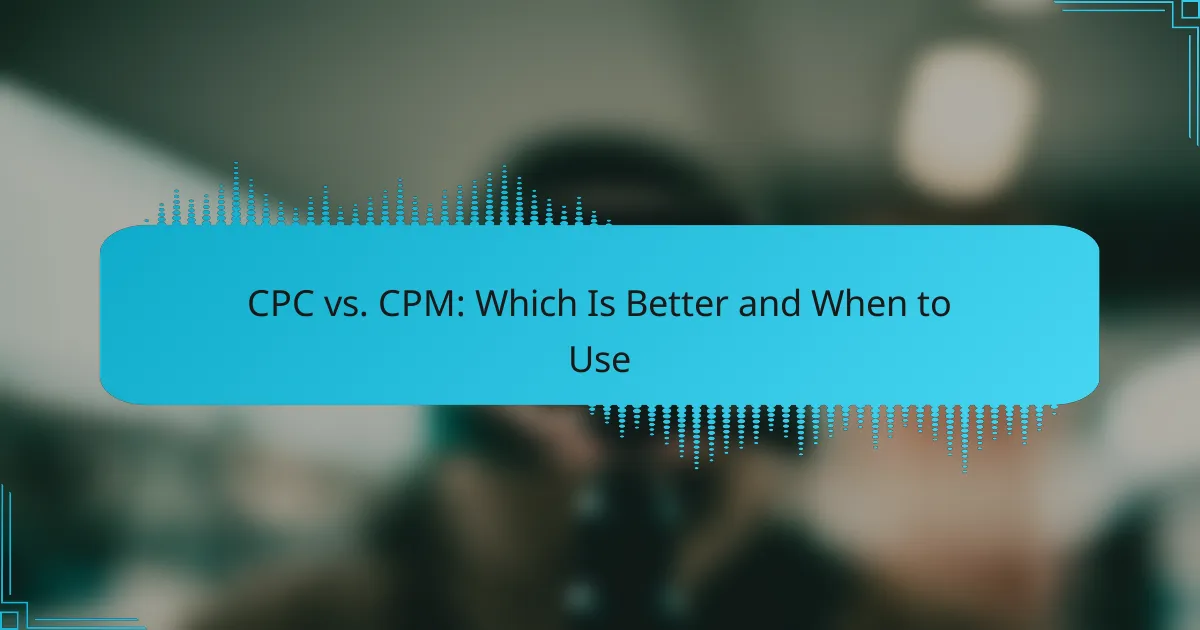Understanding the differences between Cost Per Click (CPC) and Cost Per Mille (CPM) is crucial for optimizing your advertising strategy. CPC allows advertisers to pay only when users engage with their ads, making it ideal for campaigns aimed at driving traffic and conversions. In contrast, CPM focuses on impressions, making it a better choice for enhancing brand visibility and awareness. Choosing the right model depends on your specific campaign goals and desired outcomes.
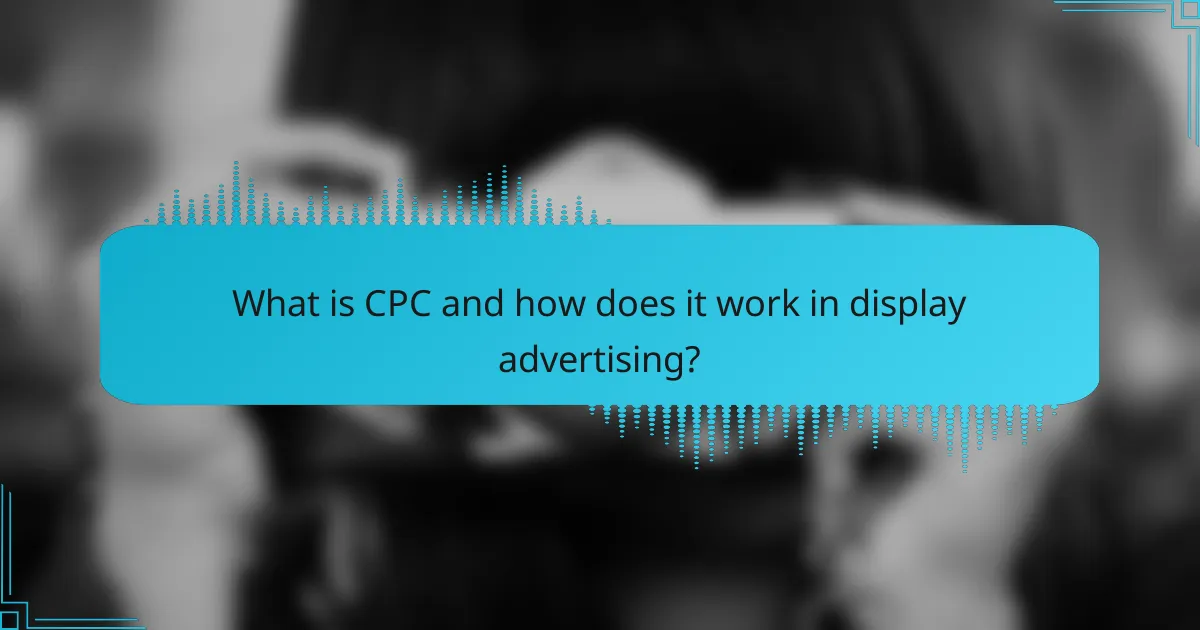
What is CPC and how does it work in display advertising?
CPC, or Cost Per Click, is a pricing model in display advertising where advertisers pay each time a user clicks on their ad. This method allows advertisers to directly link their spending to user engagement, making it a popular choice for campaigns focused on driving traffic to websites.
CPC definition
CPC stands for Cost Per Click, which is a digital advertising payment model. In this model, advertisers only incur costs when a user clicks on their ad, rather than when the ad is displayed. This approach is particularly effective for campaigns aiming to generate leads or sales through direct user interaction.
CPC calculation method
The CPC is calculated by dividing the total cost of the ad campaign by the number of clicks received. For example, if an advertiser spends $100 on a campaign and receives 50 clicks, the CPC would be $2. This straightforward calculation helps advertisers understand their spending efficiency.
Benefits of CPC
CPC offers several advantages for advertisers. First, it ensures that costs are directly tied to user engagement, allowing for better budget control. Additionally, it can lead to higher return on investment (ROI) when ads are well-targeted, as advertisers only pay for actual clicks rather than impressions.
Another benefit is the ability to track performance easily. Advertisers can analyze click-through rates (CTR) and adjust their strategies based on which ads are performing best. This data-driven approach helps in optimizing campaigns for better results.

What is CPM and how does it work in display advertising?
CPM, or Cost Per Mille, refers to the cost an advertiser pays for one thousand impressions of their ad. In display advertising, it is a common pricing model where advertisers are charged based on the number of times their ad is shown, regardless of whether users interact with it.
CPM definition
CPM stands for Cost Per Mille, with “mille” meaning thousand in Latin. This metric is used to measure the cost of displaying an advertisement one thousand times. Advertisers often choose CPM when their goal is to increase brand visibility rather than drive immediate clicks or conversions.
CPM calculation method
The CPM is calculated using the formula: CPM = (Total Cost of the Campaign / Total Impressions) x 1000. For example, if an advertiser spends $500 for 200,000 impressions, the CPM would be ($500 / 200,000) x 1000, resulting in a CPM of $2.50.
Benefits of CPM
One of the main benefits of using CPM is that it allows advertisers to reach a large audience quickly, making it ideal for brand awareness campaigns. Additionally, CPM can be more cost-effective for campaigns focused on visibility, as it often results in lower costs per impression compared to other models like CPC (Cost Per Click).
However, advertisers should be cautious of potential pitfalls, such as ensuring that their ads are displayed in relevant contexts and not just aiming for high impression numbers. Monitoring engagement metrics can help assess the effectiveness of CPM campaigns and guide future advertising strategies.
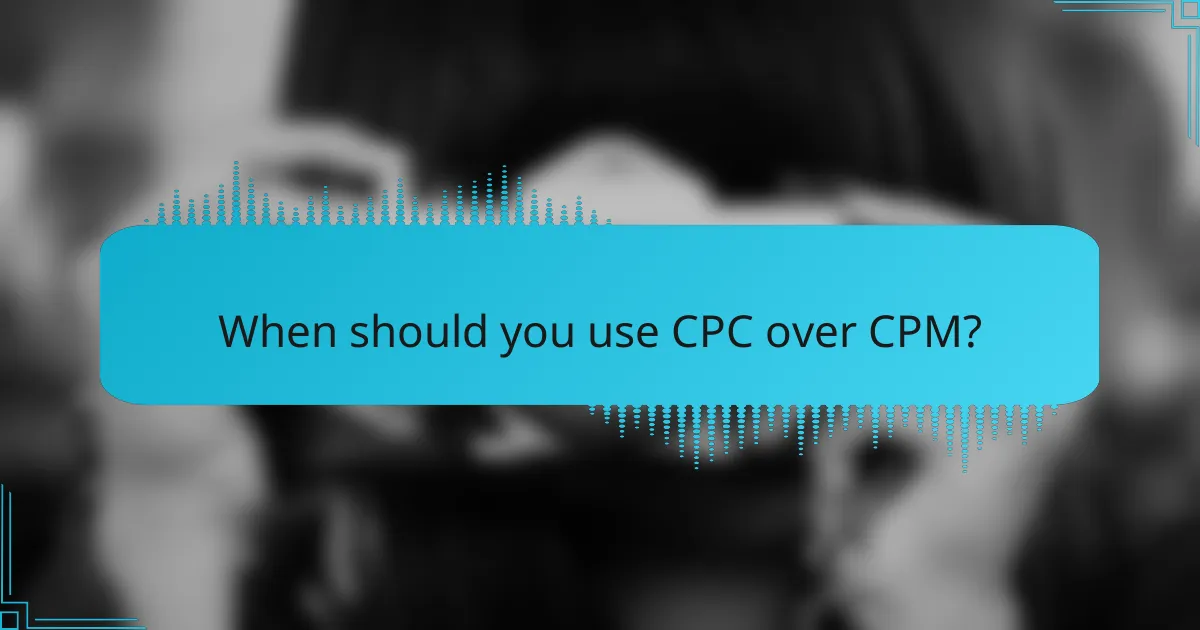
When should you use CPC over CPM?
You should use Cost Per Click (CPC) when your primary goal is to drive traffic to your website and generate leads or conversions. CPC is ideal for campaigns focused on measurable actions, while Cost Per Mille (CPM) is better suited for brand awareness and visibility.
Best scenarios for CPC
CPC is most effective when you want to target specific audiences and encourage them to take immediate action, such as signing up for a newsletter or making a purchase. For instance, if you’re running an e-commerce site, using CPC can help you attract users who are more likely to convert into paying customers.
Additionally, CPC works well for time-sensitive promotions, where you want to maximize clicks during a limited-time offer. Setting a clear budget for each click can help you control costs while optimizing your return on investment.
Best scenarios for CPM
CPM is ideal for campaigns aimed at increasing brand awareness and reaching a larger audience without the immediate expectation of clicks. If your goal is to build recognition for a new product or service, CPM allows you to showcase your brand to a wide demographic efficiently.
This model is particularly useful in display advertising, where impressions matter more than direct actions. For example, if you are launching a new campaign and want to ensure maximum visibility, using CPM can help you achieve that by focusing on the number of times your ad is shown rather than the number of clicks it receives.

How do CPC and CPM compare in performance?
CPC (Cost Per Click) and CPM (Cost Per Mille) are two distinct pricing models used in online advertising, each with unique performance metrics. CPC focuses on the cost incurred for each click on an ad, while CPM charges advertisers for every thousand impressions, making them suitable for different marketing objectives.
CPC vs CPM cost-effectiveness
CPC can be more cost-effective for campaigns aimed at driving traffic and conversions, as you only pay when a user clicks on your ad. This model is particularly beneficial for businesses that prioritize measurable actions, such as sales or sign-ups.
On the other hand, CPM is often more economical for brand awareness campaigns where the goal is to reach a larger audience without necessarily requiring immediate interaction. Advertisers may find that CPM offers a lower cost per impression, making it suitable for building brand visibility.
Audience engagement comparison
CPC typically results in higher audience engagement since advertisers pay for actual clicks, indicating interest in the ad content. This model encourages advertisers to create compelling ads that drive users to take action, fostering a more interactive experience.
Conversely, CPM may lead to lower engagement rates, as impressions do not guarantee user interaction. However, it can still be effective for campaigns focused on exposure, as reaching a wide audience can enhance brand recognition over time.

What factors influence the choice between CPC and CPM?
The choice between Cost Per Click (CPC) and Cost Per Mille (CPM) is influenced by campaign objectives, target audience characteristics, and the desired outcomes of advertising efforts. Understanding these factors helps advertisers select the most effective pricing model for their specific needs.
Campaign goals
Campaign goals play a crucial role in deciding between CPC and CPM. If the primary objective is to drive traffic to a website or generate leads, CPC is often more suitable, as advertisers only pay when users click on their ads. Conversely, if the aim is to increase brand awareness or reach a larger audience, CPM may be more effective, as it charges based on impressions rather than clicks.
For example, a company launching a new product might prefer CPM to maximize visibility, while a business focused on conversions might choose CPC to ensure they only pay for actual engagement. Aligning the pricing model with campaign goals is essential for optimizing advertising spend.
Target audience characteristics
Understanding the target audience is vital when choosing between CPC and CPM. If the audience is highly engaged and likely to click on ads, CPC can provide better value by focusing on actual interactions. However, if the audience is broader and the goal is to create general awareness, CPM can be more cost-effective for reaching a larger number of potential customers.
Additionally, consider the platforms where the audience spends their time. For instance, social media platforms may favor CPM for brand awareness campaigns, while search engines may be better suited for CPC, as users are actively searching for specific products or services. Tailoring the approach based on audience behavior can enhance campaign effectiveness.
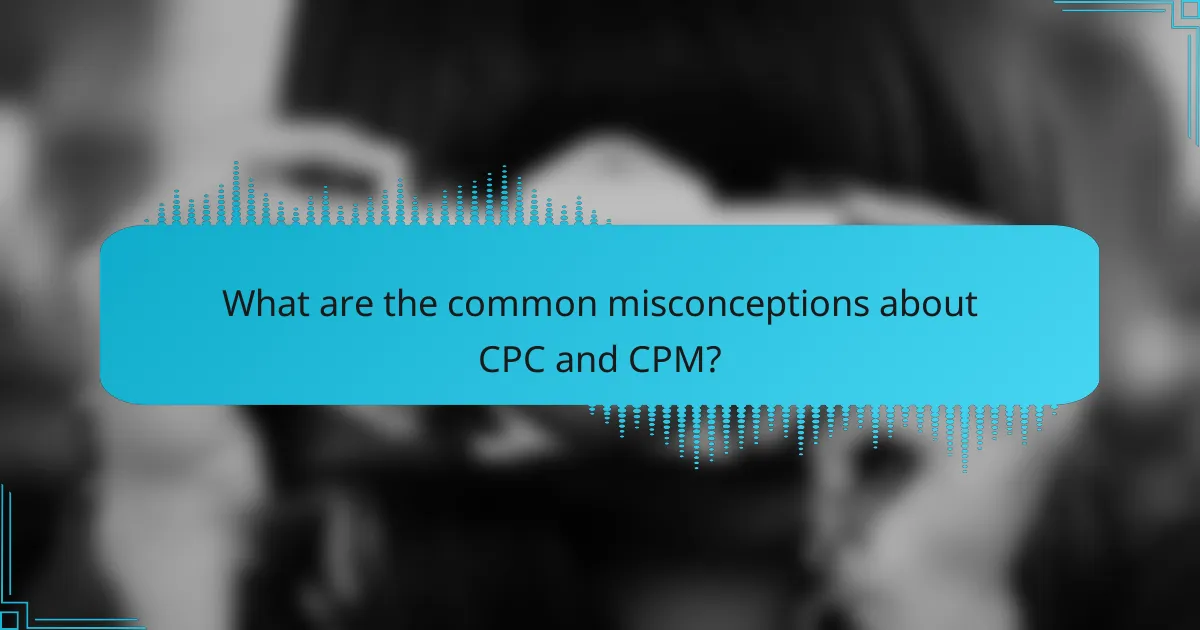
What are the common misconceptions about CPC and CPM?
Many advertisers misunderstand CPC (Cost Per Click) and CPM (Cost Per Mille) by assuming one is universally better than the other. Each model has distinct advantages and is suited for different advertising goals, making it essential to choose based on specific campaign objectives.
Misconception one
One common misconception is that CPC is always more cost-effective than CPM. While CPC can be beneficial for campaigns focused on driving traffic, CPM may offer better value for brand awareness initiatives where impressions are more critical than clicks. For instance, if your goal is to increase visibility rather than immediate action, CPM can be a more efficient choice.
Additionally, CPC can lead to higher costs if the click-through rate (CTR) is low. Advertisers may end up paying more for clicks that do not convert, while CPM allows for broader reach at a fixed cost per thousand impressions, which can be advantageous in certain contexts.
Misconception two
Another misconception is that CPM guarantees higher engagement than CPC. In reality, engagement rates depend more on the quality of the ad and its relevance to the audience than the pricing model used. A well-targeted CPM campaign can achieve high visibility without necessarily translating to clicks or interactions.
Moreover, advertisers often overlook that CPC campaigns can be optimized for engagement by focusing on compelling ad copy and targeting strategies. Understanding your audience and aligning your objectives with the right model is crucial for maximizing campaign effectiveness, regardless of whether you choose CPC or CPM.
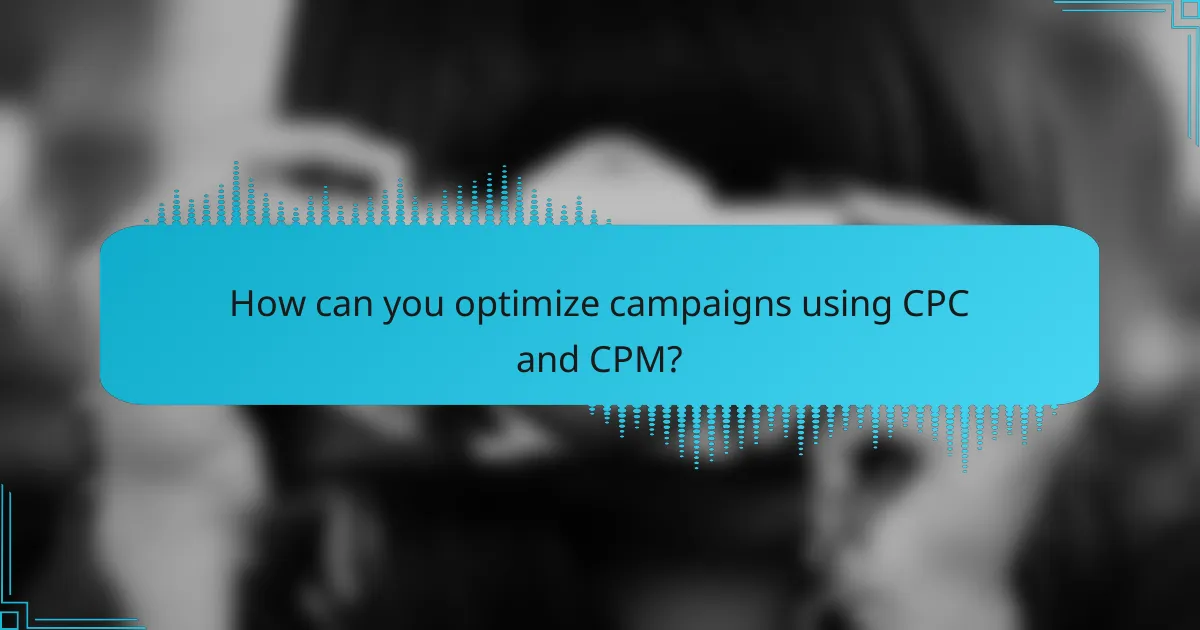
How can you optimize campaigns using CPC and CPM?
Optimizing campaigns using CPC (Cost Per Click) and CPM (Cost Per Mille) involves understanding your goals and adjusting strategies accordingly. CPC is ideal for driving traffic, while CPM is better for brand awareness. Choosing the right approach can significantly enhance your campaign’s effectiveness.
Strategies for CPC optimization
To optimize CPC campaigns, focus on targeting the right audience and using relevant keywords. Conduct thorough keyword research to identify high-intent phrases that align with your offerings. Regularly update your ad copy and landing pages to improve Quality Score, which can lower costs.
Utilize A/B testing to compare different ad variations, adjusting bids based on performance. Monitor click-through rates (CTR) closely; a higher CTR often leads to lower CPC. Set daily or monthly budgets to control spending while maximizing visibility.
Strategies for CPM optimization
For CPM campaigns, prioritize audience segmentation to ensure your ads reach the most relevant viewers. Use demographic and behavioral data to refine your targeting, which can enhance engagement and brand recall. Consider using retargeting strategies to reach users who have previously interacted with your brand.
Monitor ad placements and adjust based on performance metrics. High-quality visuals and compelling messaging can improve engagement rates. Keep an eye on frequency to avoid ad fatigue, which can diminish effectiveness over time.
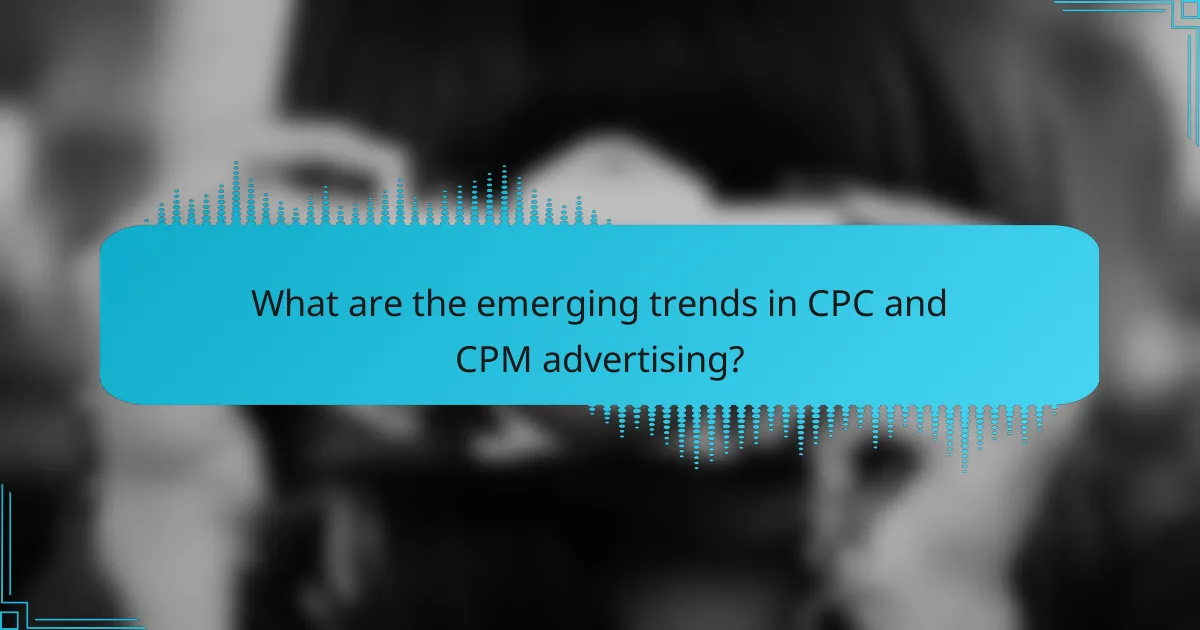
What are the emerging trends in CPC and CPM advertising?
Emerging trends in CPC (Cost Per Click) and CPM (Cost Per Mille) advertising indicate a shift towards more data-driven strategies and enhanced targeting capabilities. Advertisers are increasingly leveraging artificial intelligence and machine learning to optimize campaigns, making real-time adjustments based on performance metrics.
Increased focus on data analytics
Data analytics is becoming central to both CPC and CPM advertising strategies. Advertisers are using advanced analytics tools to track user behavior and engagement, allowing for more precise targeting and improved ROI. This trend emphasizes the importance of understanding audience demographics and preferences to tailor advertising efforts effectively.
Shift towards programmatic advertising
Programmatic advertising continues to gain traction, automating the buying and selling of ad space. This method allows for real-time bidding and more efficient ad placements, which can lead to better performance for both CPC and CPM campaigns. Advertisers benefit from reduced costs and increased reach through programmatic platforms.
Emphasis on mobile and video ads
With the rise of mobile usage, there is a significant shift towards mobile and video ads in CPC and CPM strategies. Advertisers are focusing on creating engaging video content that captures attention quickly, as video ads often yield higher engagement rates. This trend reflects the changing consumption habits of users who prefer visual content over traditional text-based ads.
Integration of artificial intelligence
Artificial intelligence is revolutionizing CPC and CPM advertising by enabling more sophisticated targeting and personalization. AI algorithms can analyze vast amounts of data to predict user behavior, allowing advertisers to optimize their campaigns for better performance. This integration helps in reducing costs and increasing conversion rates.
Growing importance of brand safety
Brand safety has become a critical concern in digital advertising, influencing both CPC and CPM strategies. Advertisers are increasingly prioritizing placements that align with their brand values and avoiding environments that could harm their reputation. This trend necessitates thorough vetting of ad placements and a focus on transparency in advertising practices.
